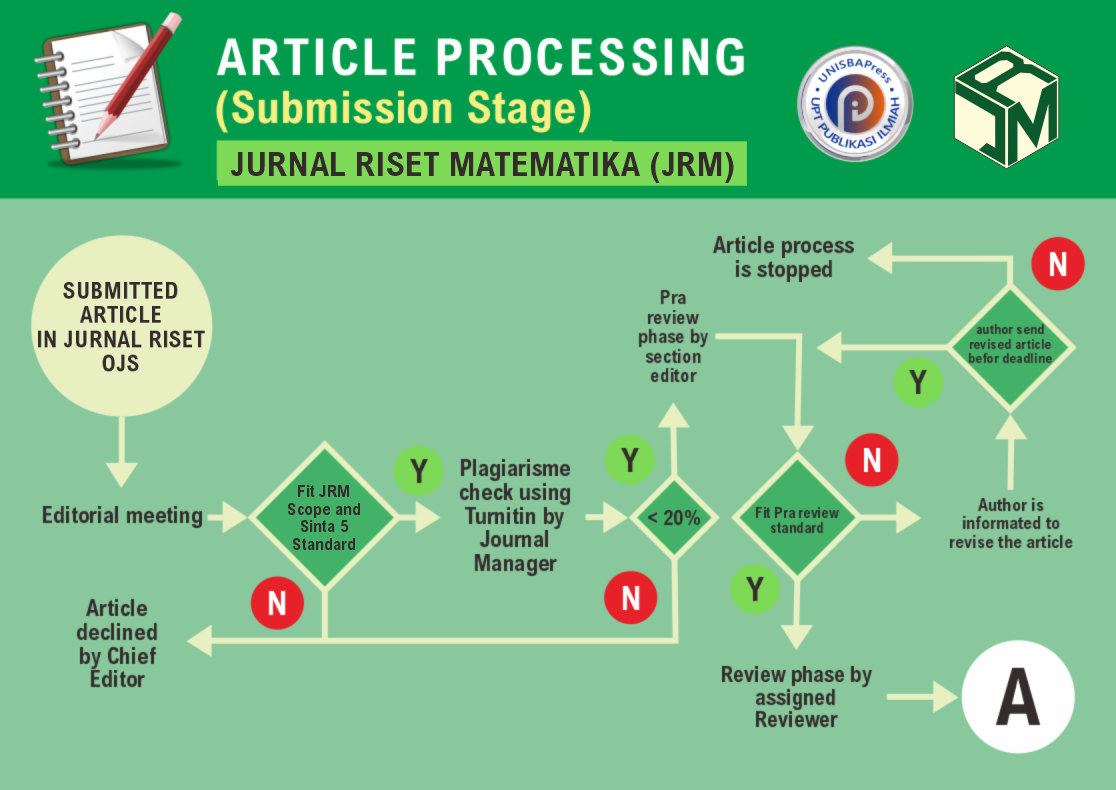Model SEIR Penyebaran Covid-19 dengan Parameter Penggunaan Masker Kesehatan dan Vaksinasi
DOI:
https://doi.org/10.29313/jrm.v3i1.1731Keywords:
Covid-19, Model SEIR, Titik EkuilibriumAbstract
Abstract. In Mathematics, research on the spread of a disease can be carried out by establishing an epidemiological model. One type of epidemiological model is the SEIR model. In this study, the SEIR model was developed to determine the effect of mask wearing and vaccination on the spread of Covid-19. The entire population was divided into six compartments, mask wearing and non mask wearing susceptible compartments, exposed compartment, mask wearing and non mask wearing infected compartments, and recovered compartment. The model for the spread of Covid-19 was formed by compiling a compartment diagram for the spread of Covid-19 disease with the parameters of mask wearing and vaccination first. Then, disease-free equilibrium point, endemic equilibrium point, and Basic Reproduction Number are determined. After that, numerical simulation was carried out. The results of this study indicate that the disease-free equilibrium point is locally asymptotically stable when the Basic Reproduction Number is less than one. Meanwhile, the endemic equilibrium point is locally asymptotically stable when the Basic Reproduction Number is larger than one. In addition, this study also shows that mask wearing and vaccinations reduce the value of Basic Reproduction Number.
Abstrak. Dalam bidang Matematika, penelitian mengenai penyebaran penyakit dapat dilakukan dengan membentuk model epidemiologi. Salah satu jenis model epidemiologi adalah model SEIR. Pada penelitian ini, model SEIR dikembangkan untuk mengetahui pengaruh penggunaan masker kesehatan dan vaksinasi terhadap penyebaran penyakit Covid-19. Keseluruhan populasi dibagi menjadi enam kompartemen, yaitu kompartemen rentan yang tidak menggunakan masker kesehatan, kompartemen rentan yang menggunakan masker kesehatan, kompartemen terpapar, kompartemen terinfeksi yang tidak menggunakan masker kesehatan, kompartemen terinfeksi yang menggunakan masker kesehatan, dan kompartemen sembuh. Model penyebaran Covid-19 dibentuk dengan menyusun diagram kompartemen penyebaran penyakit Covid-19 dengan parameter penggunaan masker kesehatan dan vaksinasi terlebih dahulu. Setelah model Matematika terbentuk, dilakukan penentuan titik ekuilibrium bebas penyakit, titik ekuilibrium endemik, dan Basic Reproduction Number. Kemudian, dilakukan simulasi numerik. Hasil dari penelitian ini menunjukkan bahwa titik ekuilibrium bebas penyakit bersifat stabil asimtotik lokal saat nilai basic reproduction kurang dari satu. Sementara itu, titik ekuilibrium endemik bersifat stabil asimtotik lokal saat nilai Basic Reproduction Number lebih dari satu. Selain itu, penelitian ini juga menunjukkan bahwa penggunaan masker kesehatan dan vaksinasi berperan dalam penurunan nilai Basic Reproduction Number.
References
[2] A. Gupta, S. Kashte, M. Gupta, H. C. Rodriguez, S. S. Gautam, and S. Kadam, “Mesenchymal stem cells and exosome therapy for COVID-19: current status and future perspective,” Hum. Cell, vol. 33, no. 4, pp. 907–918, 2020, doi: 10.1007/s13577-020-00407-w.
[3] M. Manaqib, I. Fauziah, and M. Mujiyanti, “Mathematical Model for MERS-COV Disease Transmission with Medical Mask Usage and Vaccination,” Inpr. Indones. J. Pure Appl. Math., vol. 1, no. 2, pp. 97–109, 2019, doi: 10.15408/inprime.v1i2.13553.
[4] F. Brauer, C. Castillo-Chavez, and Z. Feng, Mathematical Models in Epidemiology. New York: Springer, 2019. doi: 10.1007/978-1-4939-9828-9_17.
[5] C. Castillo-Chavez, Z. Feng, and W. Huang, “On The Computation of R0 and Its Role on Global Stability,” no. February, 2001.
[6] BPS, “Jumlah Penduduk Pertengahan Tahun (Ribu Jiwa), 2020-2022.” https://www.bps.go.id/indicator/12/1975/1/jumlah-penduduk-pertengahan-tahun.html
[7] S. Annas, M. I. Pratama, M. Rifandi, W. Sanusi, and S. Side, “Stability analysis and numerical simulation of SEIR model for pandemic COVID-19 spread in Indonesia,” no. January, 2020.
[8] J. A. Spencer et al., “Epidemiological parameter review and comparative dynamics of influenza, respiratory syncytial virus, rhinovirus, human coronavirus, and adenovirus,” medRxiv, p. 2020.02.04.20020404, 2020, [Online]. Available: https://www.medrxiv.org/content/10.1101/2020.02.04.20020404v1%0Ahttps://www.medrxiv.org/content/10.1101/2020.02.04.20020404v1.abstract
[9] A. Aschengrau and G. R. Seage, Essentials of Epidemiology in Public Health. 2020.













